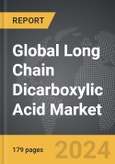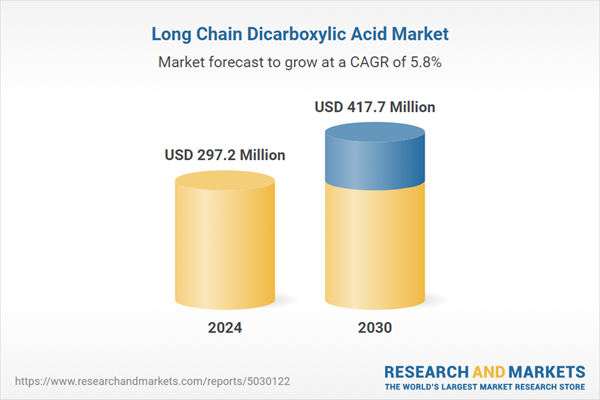The global market for Long Chain Dicarboxylic Acid was valued at US$297.2 Million in 2024 and is projected to reach US$417.7 Million by 2030, growing at a CAGR of 5.8% from 2024 to 2030. This comprehensive report provides an in-depth analysis of market trends, drivers, and forecasts, helping you make informed business decisions. The report includes the most recent global tariff developments and how they impact the Long Chain Dicarboxylic Acid market.
Segments: Application (Nylon / Polyamides, Lubricants, Corrosion Inhibitors, Powder Coatings, Adhesives, Pharmaceuticals, Other Applications).
Geographic Regions/Countries: World; United States; Canada; Japan; China; Europe (France; Germany; Italy; United Kingdom; Spain; Russia; and Rest of Europe); Asia-Pacific (Australia; India; South Korea; and Rest of Asia-Pacific); Latin America (Argentina; Brazil; Mexico; and Rest of Latin America); Middle East (Iran; Israel; Saudi Arabia; United Arab Emirates; and Rest of Middle East); and Africa.
The analysts continuously track trade developments worldwide, drawing insights from leading global economists and over 200 industry and policy institutions, including think tanks, trade organizations, and national economic advisory bodies. This intelligence is integrated into forecasting models to provide timely, data-driven analysis of emerging risks and opportunities.
Global Long Chain Dicarboxylic Acid Market - Key Trends & Drivers Summarized
What Are Long Chain Dicarboxylic Acids and Where Are They Used?
Long chain dicarboxylic acids (LCDA) are a group of naturally occurring or synthetically produced organic compounds featuring two carboxyl functional groups attached to a long aliphatic carbon chain, typically containing more than ten carbon atoms. These acids are pivotal in the synthesis of high-performance polymers, nylons, and resins, due to their ability to impart durability, flexibility, and resistance to chemicals and temperature variations. In the industrial sector, LCDAs are used in the manufacture of corrosion inhibitors, lubricants, and adhesives, enhancing the performance and lifespan of machinery and equipment. Additionally, their biodegradability makes them appealing in the development of eco-friendly products, aligning with increasing regulatory and consumer demand for sustainable materials.How Is the Production of Long Chain Dicarboxylic Acids Evolving?
The production of long chain dicarboxylic acids has significantly evolved with advances in biotechnology and chemical synthesis. Traditional petrochemical processes are gradually being supplemented or replaced by bio-based methods that utilize renewable feedstocks such as vegetable oils and microbial fermentation. This shift is driven by the need to reduce dependency on fossil fuels and decrease carbon emissions associated with industrial processes. Fermentation, in particular, has gained attention for its ability to produce high-purity and structurally diverse LCDAs, which are crucial for high-performance applications. Innovations in genetic engineering and metabolic engineering are enhancing the efficiency and yield of bio-based production routes, opening up new possibilities for cost-effective and environmentally friendly LCDA synthesis.What Role Do Regulatory Frameworks Play in the LCDA Market?
Regulatory frameworks significantly impact the LCDA market, particularly in regions with stringent environmental laws. In Europe and North America, regulations such as REACH (Registration, Evaluation, Authorisation and Restriction of Chemicals) and TSCA (Toxic Substances Control Act) govern the production and use of chemicals, including long chain dicarboxylic acids. These regulations mandate the assessment and management of risks associated with chemical substances, promoting the use of safer and more sustainable alternatives. As a result, there is a growing preference for bio-based LCDAs in these regions, which are perceived as less harmful to human health and the environment. Furthermore, policies encouraging the reduction of greenhouse gas emissions and reliance on sustainable materials continue to drive research and development in bio-based LCDA production technologies.What Drives the Growth in the Long Chain Dicarboxylic Acid Market?
The growth in the long chain dicarboxylic acid market is driven by several factors related to technological innovations, shifts in end-user industries, and changing regulatory landscapes. The increasing adoption of bio-based products across various sectors, including automotive, aerospace, and consumer goods, fuels demand for sustainable and high-performance materials like LCDAs. Technological advancements in the production of bio-based LCDAs, which offer improved properties and environmental benefits, are making these materials more competitive against traditional petrochemical-derived products. Consumer behavior is also shifting towards more sustainable and eco-friendly products, which boosts the demand for LCDAs in applications such as eco-friendly plastics and biodegradable textiles. Moreover, the expansion of industries in emerging economies presents new opportunities for the application of LCDAs in manufacturing processes. With regulatory bodies worldwide tightening environmental norms, the push towards green chemistry practices further propels the LCDA market growth, as industries seek compliant, sustainable alternatives to conventional acids.Report Scope
The report analyzes the Long Chain Dicarboxylic Acid market, presented in terms of units. The analysis covers the key segments and geographic regions outlined below.Segments: Application (Nylon / Polyamides, Lubricants, Corrosion Inhibitors, Powder Coatings, Adhesives, Pharmaceuticals, Other Applications).
Geographic Regions/Countries: World; United States; Canada; Japan; China; Europe (France; Germany; Italy; United Kingdom; Spain; Russia; and Rest of Europe); Asia-Pacific (Australia; India; South Korea; and Rest of Asia-Pacific); Latin America (Argentina; Brazil; Mexico; and Rest of Latin America); Middle East (Iran; Israel; Saudi Arabia; United Arab Emirates; and Rest of Middle East); and Africa.
Key Insights:
- Market Growth: Understand the significant growth trajectory of the Nylon / Polyamides segment, which is expected to reach US$194.3 Million by 2030 with a CAGR of a 5.7%. The Lubricants segment is also set to grow at 6.3% CAGR over the analysis period.
- Regional Analysis: Gain insights into the U.S. market, valued at $77.7 Million in 2024, and China, forecasted to grow at an impressive 8.7% CAGR to reach $95.3 Million by 2030. Discover growth trends in other key regions, including Japan, Canada, Germany, and the Asia-Pacific.
Why You Should Buy This Report:
- Detailed Market Analysis: Access a thorough analysis of the Global Long Chain Dicarboxylic Acid Market, covering all major geographic regions and market segments.
- Competitive Insights: Get an overview of the competitive landscape, including the market presence of major players across different geographies.
- Future Trends and Drivers: Understand the key trends and drivers shaping the future of the Global Long Chain Dicarboxylic Acid Market.
- Actionable Insights: Benefit from actionable insights that can help you identify new revenue opportunities and make strategic business decisions.
Key Questions Answered:
- How is the Global Long Chain Dicarboxylic Acid Market expected to evolve by 2030?
- What are the main drivers and restraints affecting the market?
- Which market segments will grow the most over the forecast period?
- How will market shares for different regions and segments change by 2030?
- Who are the leading players in the market, and what are their prospects?
Report Features:
- Comprehensive Market Data: Independent analysis of annual sales and market forecasts in US$ Million from 2024 to 2030.
- In-Depth Regional Analysis: Detailed insights into key markets, including the U.S., China, Japan, Canada, Europe, Asia-Pacific, Latin America, Middle East, and Africa.
- Company Profiles: Coverage of players such as Alfa Chemistry, BASF SE, Cathay Industrial Biotech Ltd., DAYANG CHEM (HANGZHOU) CO., LTD, Evonik Industries AG and more.
- Complimentary Updates: Receive free report updates for one year to keep you informed of the latest market developments.
Some of the 11 companies featured in this Long Chain Dicarboxylic Acid market report include:
- Alfa Chemistry
- BASF SE
- Cathay Industrial Biotech Ltd.
- DAYANG CHEM (HANGZHOU) CO., LTD
- Evonik Industries AG
- Henan Junheng Industrial Group Biotechnology Co.,Ltd
- TCI America, Inc.
- UBE Corportion
- Xiamen Aeco Chemical Industrial Co., Ltd.
- Zibo Guangtong Chemical Co., Ltd.
Tariff Impact Analysis: Key Insights for 2025
Global tariff negotiations across 180+ countries are reshaping supply chains, costs, and competitiveness. This report reflects the latest developments as of April 2025 and incorporates forward-looking insights into the market outlook.The analysts continuously track trade developments worldwide, drawing insights from leading global economists and over 200 industry and policy institutions, including think tanks, trade organizations, and national economic advisory bodies. This intelligence is integrated into forecasting models to provide timely, data-driven analysis of emerging risks and opportunities.
What’s Included in This Edition:
- Tariff-adjusted market forecasts by region and segment
- Analysis of cost and supply chain implications by sourcing and trade exposure
- Strategic insights into geographic shifts
Buyers receive a free July 2025 update with:
- Finalized tariff impacts and new trade agreement effects
- Updated projections reflecting global sourcing and cost shifts
- Expanded country-specific coverage across the industry
Table of Contents
I. METHODOLOGYII. EXECUTIVE SUMMARY2. FOCUS ON SELECT PLAYERSIII. MARKET ANALYSISSOUTH KOREAREST OF ASIA-PACIFICARGENTINABRAZILMEXICOREST OF LATIN AMERICAIRANISRAELSAUDI ARABIAUNITED ARAB EMIRATESREST OF MIDDLE EASTIV. COMPETITION
1. MARKET OVERVIEW
3. MARKET TRENDS & DRIVERS
4. GLOBAL MARKET PERSPECTIVE
UNITED STATES
CANADA
JAPAN
CHINA
EUROPE
FRANCE
GERMANY
ITALY
UNITED KINGDOM
SPAIN
RUSSIA
REST OF EUROPE
ASIA-PACIFIC
AUSTRALIA
INDIA
LATIN AMERICA
MIDDLE EAST
AFRICA
Companies Mentioned (Partial List)
A selection of companies mentioned in this report includes, but is not limited to:
- Alfa Chemistry
- BASF SE
- Cathay Industrial Biotech Ltd.
- DAYANG CHEM (HANGZHOU) CO., LTD
- Evonik Industries AG
- Henan Junheng Industrial Group Biotechnology Co.,Ltd
- TCI America, Inc.
- UBE Corportion
- Xiamen Aeco Chemical Industrial Co., Ltd.
- Zibo Guangtong Chemical Co., Ltd.
Table Information
| Report Attribute | Details |
|---|---|
| No. of Pages | 179 |
| Published | April 2025 |
| Forecast Period | 2024 - 2030 |
| Estimated Market Value ( USD | $ 297.2 Million |
| Forecasted Market Value ( USD | $ 417.7 Million |
| Compound Annual Growth Rate | 5.8% |
| Regions Covered | Global |









